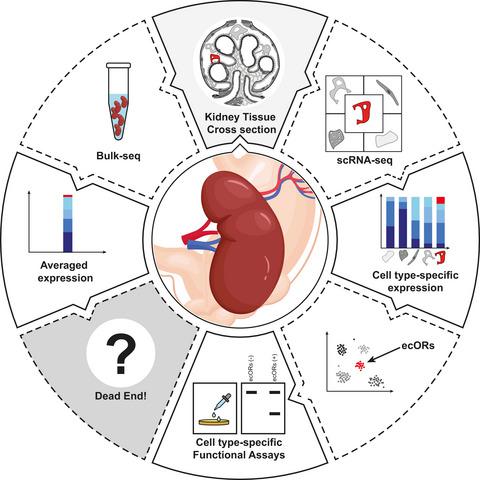Our official English website, www.x-mol.net, welcomes your feedback! (Note: you will need to create a separate account there.)
Challenges and possible solutions for decoding extranasal olfactory receptors
The FEBS Journal ( IF 5.4 ) Pub Date : 2020-10-21 , DOI: 10.1111/febs.15606 Siddhant Kalra 1 , Aayushi Mittal 1 , Manisha Bajoria 1 , Tripti Mishra 2 , Sidrah Maryam 1 , Debarka Sengupta 1, 3, 4, 5 , Gaurav Ahuja 1
The FEBS Journal ( IF 5.4 ) Pub Date : 2020-10-21 , DOI: 10.1111/febs.15606 Siddhant Kalra 1 , Aayushi Mittal 1 , Manisha Bajoria 1 , Tripti Mishra 2 , Sidrah Maryam 1 , Debarka Sengupta 1, 3, 4, 5 , Gaurav Ahuja 1
Affiliation

|
Olfactory receptors are primarily known to be expressed in the olfactory epithelium of the nasal cavity and therefore assist in odor perception. With the advent of high-throughput omics technologies such as tissue microarray or RNA sequencing, a large number of olfactory receptors have been reported to be expressed in the nonolfactory tissues. Although these technologies uncovered the expression of these olfactory receptors in the nonchemosensory tissues, unfortunately, they failed to reveal the information about their cell type of origin. Accurate characterization of the cell types should be the first step towards devising cell type-specific assays for their functional evaluation. Single-cell RNA-sequencing technology resolved some of these apparent limitations and opened new means to interrogate the expression of these extranasal olfactory receptors at the single-cell resolution. Moreover, the availability of large-scale, multi-organ/species single-cell expression atlases offer ample resources for the systematic reannotation of these receptors in a cell type-specific manner. In this Viewpoint article, we discuss some of the technical limitations that impede the in-depth understanding of these extranasal olfactory receptors, with a special focus on odorant receptors. Moreover, we also propose a list of single cell-based omics technologies that could further promulgate the opportunity to decipher the regulatory network that drives the odorant receptors expression at atypical locations.
中文翻译:

解码鼻外嗅觉受体的挑战和可能的解决方案
已知嗅觉受体主要在鼻腔的嗅觉上皮中表达,因此有助于气味感知。随着高通量组学的出现通过组织微阵列或 RNA 测序等技术,据报道大量的嗅觉受体在非嗅觉组织中表达。尽管这些技术揭示了这些嗅觉受体在非化学感应组织中的表达,但不幸的是,它们未能揭示有关其细胞来源类型的信息。细胞类型的准确表征应该是设计细胞类型特异性检测以进行功能评估的第一步。单细胞 RNA 测序技术解决了其中一些明显的局限性,并开辟了以单细胞分辨率询问这些鼻外嗅觉受体表达的新方法。此外,大规模的可用性,多器官/物种单细胞表达图谱为以细胞类型特异性方式系统重新注释这些受体提供了充足的资源。在这篇观点文章中,我们讨论了一些阻碍深入了解这些鼻外嗅觉受体的技术限制,特别关注气味受体。此外,我们还提出了一个基于单细胞的列表组学技术可以进一步促进破译在非典型位置驱动气味受体表达的调节网络的机会。
更新日期:2020-10-21
中文翻译:

解码鼻外嗅觉受体的挑战和可能的解决方案
已知嗅觉受体主要在鼻腔的嗅觉上皮中表达,因此有助于气味感知。随着高通量组学的出现通过组织微阵列或 RNA 测序等技术,据报道大量的嗅觉受体在非嗅觉组织中表达。尽管这些技术揭示了这些嗅觉受体在非化学感应组织中的表达,但不幸的是,它们未能揭示有关其细胞来源类型的信息。细胞类型的准确表征应该是设计细胞类型特异性检测以进行功能评估的第一步。单细胞 RNA 测序技术解决了其中一些明显的局限性,并开辟了以单细胞分辨率询问这些鼻外嗅觉受体表达的新方法。此外,大规模的可用性,多器官/物种单细胞表达图谱为以细胞类型特异性方式系统重新注释这些受体提供了充足的资源。在这篇观点文章中,我们讨论了一些阻碍深入了解这些鼻外嗅觉受体的技术限制,特别关注气味受体。此外,我们还提出了一个基于单细胞的列表组学技术可以进一步促进破译在非典型位置驱动气味受体表达的调节网络的机会。



























 京公网安备 11010802027423号
京公网安备 11010802027423号